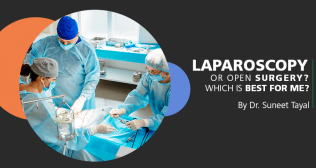
Obstetrics and Gynaecology
Fibroids: Symptoms & Treatment
Dr. Suneet Tayal Jan 21, 2021
 Fibroids are Tumors that grow in the womb. They are typically benign (non-cancerous). They can vary greatly in size and can affect up to 80% of women. The exact cause for the development of fibroids is unknown but there is a strong genetic and hereditary component.
Not all fibroids are symptomatic. Only 1 in 3 women experiences any symptoms at all. Symptoms range from mild abdominal pain to heavy menstrual periods, lower back pain, constipation, frequent micturition, and pain during intercourse. More severe and chronic complications include problems during pregnancy, repeated miscarriages, and labour problems. If a patient conceives a fibroid in the uterus, the size of the fibroid continues to increase through the pregnancy due to the production of increased amounts of ovarian hormones. Most fibroids are asymptomatic; however, severe localized abdominal pain can occur if a fibroid undergoes so-called “red degeneration,” torsion, or impaction. Pain is the most common complication of fibroids in pregnancy and is seen most often in women with fibroids > 5 cm during the second and third trimesters of pregnancy. More commonly, patients present with infertility due to the presence of fibroids in the uterus.
My patient Mrs. X, a 28-year lady married for 5 years presented with a large uterus of 20 weeks’ size with multiple fibroids causing abnormal uterine bleeding and infertility. She has advised hysterectomy as the only possible treatment modality by numerous specialists across the Tricity but she was keen to have children and came to me as a last resort. Approximate 28 fibroids of varying sizes were removed laparoscopically by me and my team and not only was she relieved of her symptoms, but she also conceived shortly after surgery and was blessed with a baby girl.
Treatment for fibroids is recommended only in symptomatic cases and in most cases successful in treating whatever symptoms ail the patient. Both medical and surgical modalities of treatment are available. While medical management is the most common treatment modality, for refractory cases, surgery is performed. Depending on the size of the fibroid and other patient factors, myomectomy or hysterectomy can be recommended and both surgeries can be performed either open or laparoscopically. Where possible, laparoscopic surgery is preferred because of faster recovery and less pressure on the uterus for subsequent pregnancies, but open surgery may be the only option in certain patients and the same is suggested to the patient after due consideration.
Fibroids are Tumors that grow in the womb. They are typically benign (non-cancerous). They can vary greatly in size and can affect up to 80% of women. The exact cause for the development of fibroids is unknown but there is a strong genetic and hereditary component.
Not all fibroids are symptomatic. Only 1 in 3 women experiences any symptoms at all. Symptoms range from mild abdominal pain to heavy menstrual periods, lower back pain, constipation, frequent micturition, and pain during intercourse. More severe and chronic complications include problems during pregnancy, repeated miscarriages, and labour problems. If a patient conceives a fibroid in the uterus, the size of the fibroid continues to increase through the pregnancy due to the production of increased amounts of ovarian hormones. Most fibroids are asymptomatic; however, severe localized abdominal pain can occur if a fibroid undergoes so-called “red degeneration,” torsion, or impaction. Pain is the most common complication of fibroids in pregnancy and is seen most often in women with fibroids > 5 cm during the second and third trimesters of pregnancy. More commonly, patients present with infertility due to the presence of fibroids in the uterus.
My patient Mrs. X, a 28-year lady married for 5 years presented with a large uterus of 20 weeks’ size with multiple fibroids causing abnormal uterine bleeding and infertility. She has advised hysterectomy as the only possible treatment modality by numerous specialists across the Tricity but she was keen to have children and came to me as a last resort. Approximate 28 fibroids of varying sizes were removed laparoscopically by me and my team and not only was she relieved of her symptoms, but she also conceived shortly after surgery and was blessed with a baby girl.
Treatment for fibroids is recommended only in symptomatic cases and in most cases successful in treating whatever symptoms ail the patient. Both medical and surgical modalities of treatment are available. While medical management is the most common treatment modality, for refractory cases, surgery is performed. Depending on the size of the fibroid and other patient factors, myomectomy or hysterectomy can be recommended and both surgeries can be performed either open or laparoscopically. Where possible, laparoscopic surgery is preferred because of faster recovery and less pressure on the uterus for subsequent pregnancies, but open surgery may be the only option in certain patients and the same is suggested to the patient after due consideration. Categories
Clear allMeet the doctor

Dr. Suneet Tayal
SENIOR CONSULTANT OBSTETRICS & GYNAECOLOGY | Fortis Mohali
- Obstetrics and Gynaecology | Obstetrics and Gynaecology | Robotic Surgery
-
45 Years
-
800



















